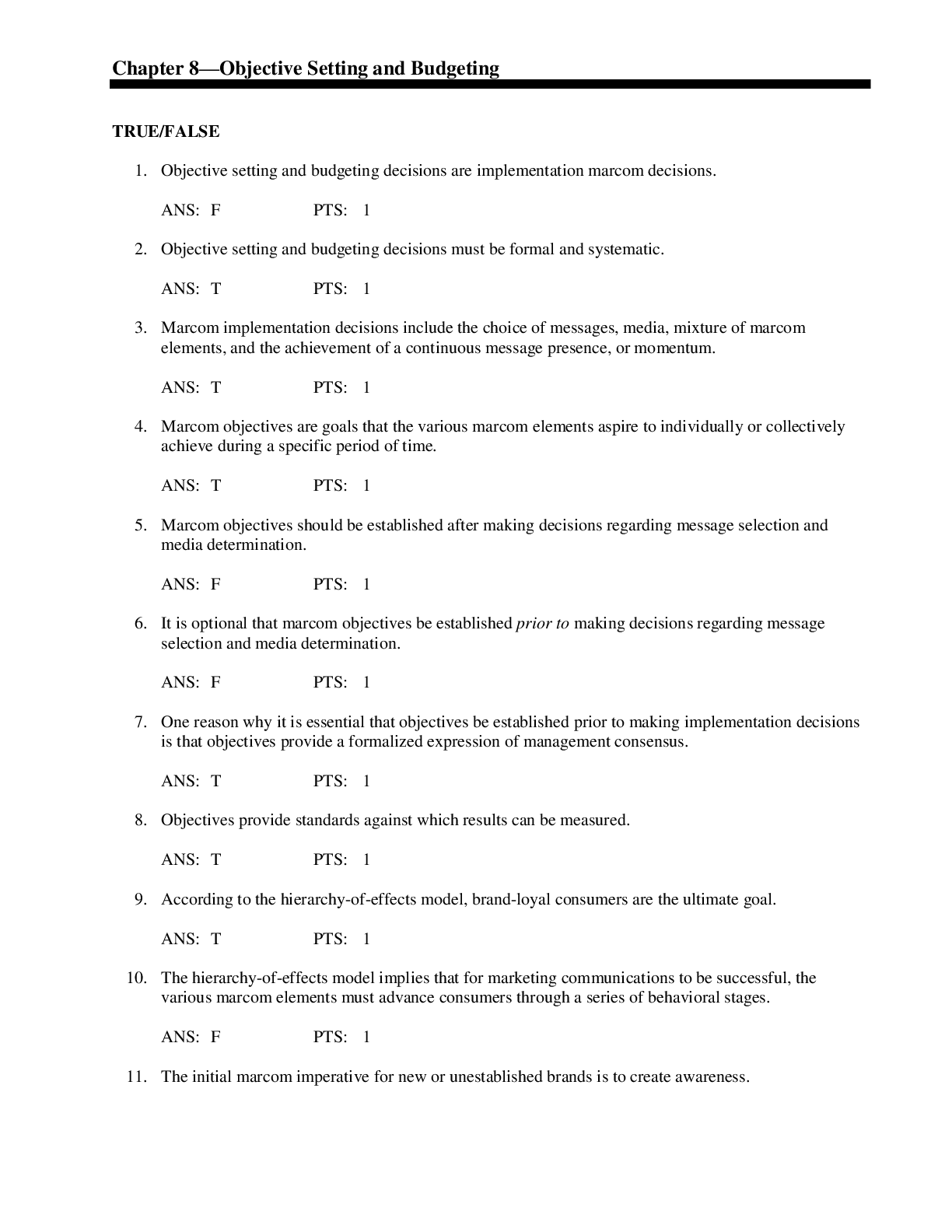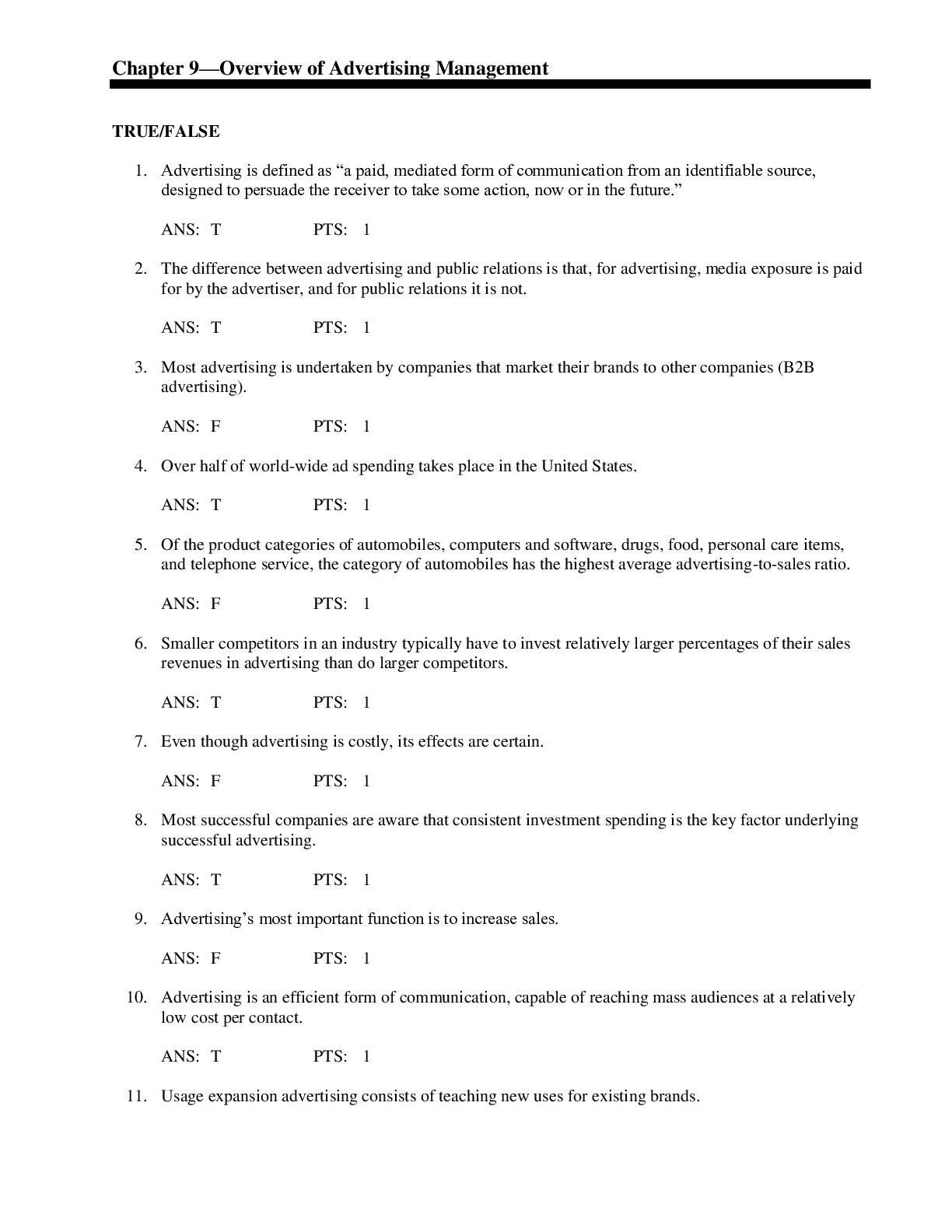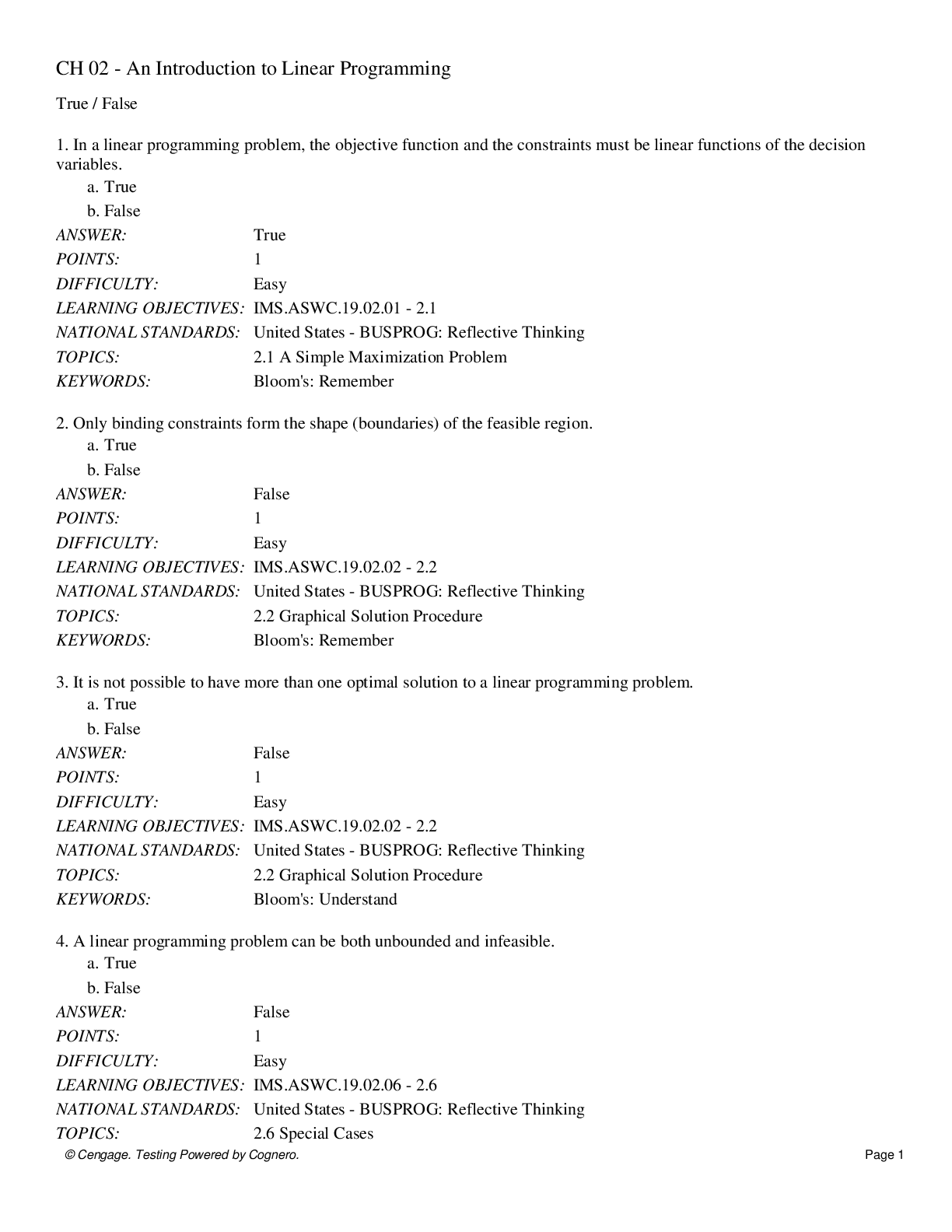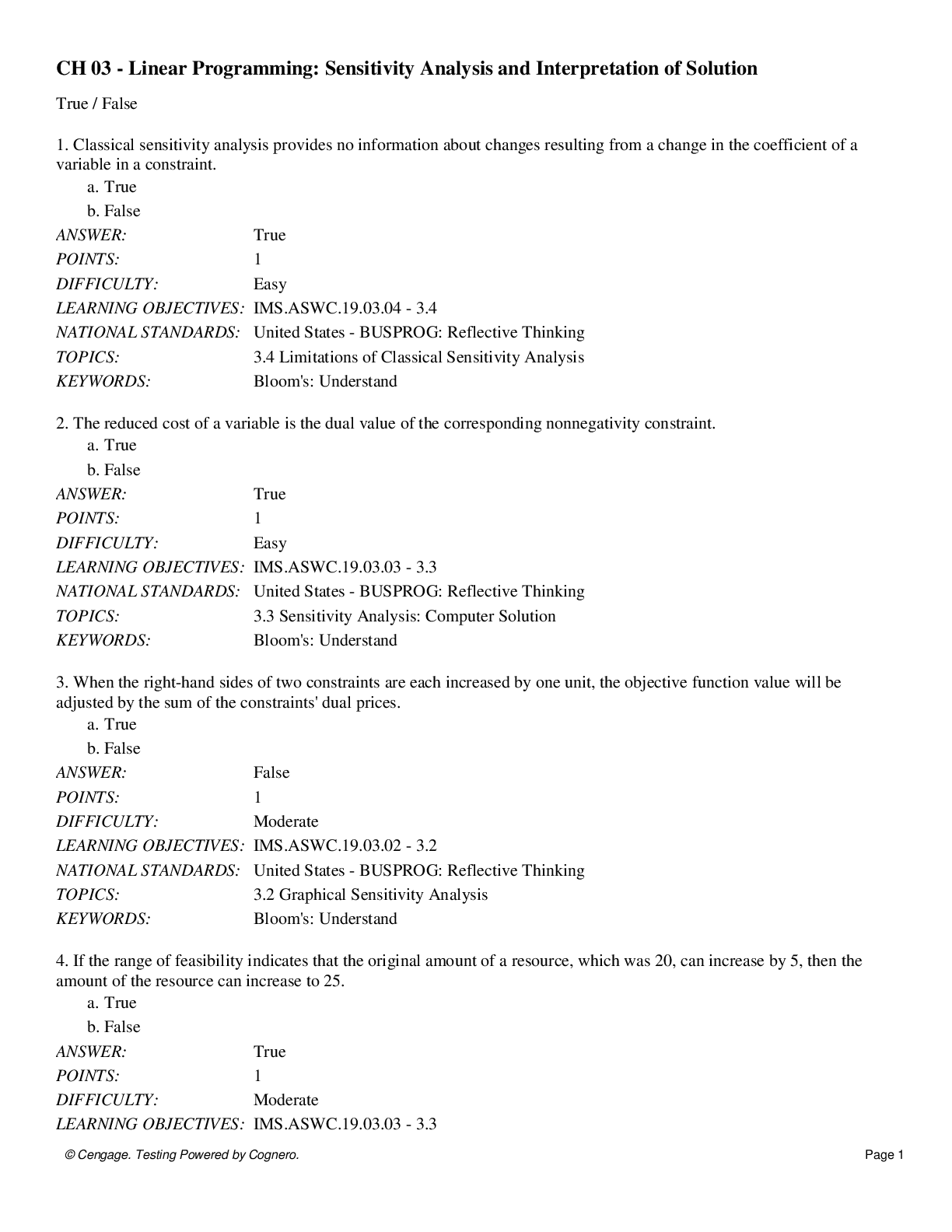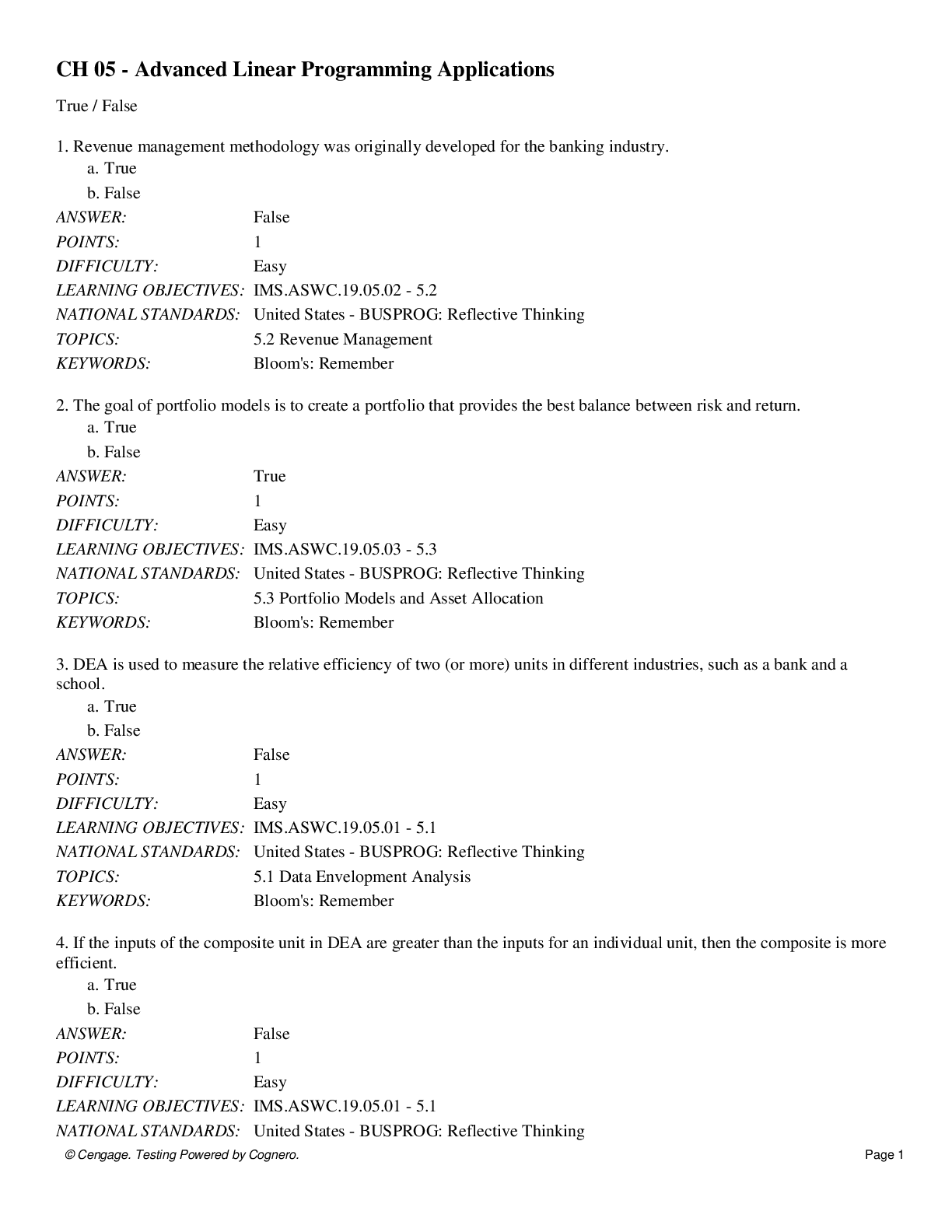Management > QUESTIONS & ANSWERS > CH 10 - Inventory Models. Questions and Answers (All)
CH 10 - Inventory Models. Questions and Answers
Document Content and Description Below
/ 1. To be considered inventory, goods must be finished and waiting for delivery. a. b. 2. When demand is independent, it is not related to demand for other components or items pr... oduced by the firm. a. b. 3. Constant demand is a key assumption of the EOQ model. a. b. 4. In the EOQ model, if the average inventory during each cycle is 1/2Q, the average inventory over any number of cycles is Q/2. a. b. 5. The single-period inventory model is most applicable to items that are perishable or have seasonal demand. a. b. 6. The time between placing orders is the lead time. a. b. 7. If the optimal production lot size decreases, average inventory increases. a. b. 8. If an item's per-unit backorder cost is greater than its per-unit holding cost, no intentional shortage should be planned. a. b. 9. It is logical to order an amount from the highest discount category when quantity discounts are available. a. b. 10. When there is probabilistic demand in a multiperiod model, the inventory level will not decrease smoothly and can fall below 0. a. b. 11. In the periodic review model, the order quantity at each review period must be sufficient to cover demand for the review period plus the demand for the following lead time. a. b. 12. Periodic review systems require smaller safety stock levels than corresponding continuous review systems. a. b. 13. The cost of overestimating demand is usually harder to determine than the cost of underestimating demand. a. b. 14. The terms "inventory on hand" and "inventory position" have the same meaning. a. b. 15. The EOQ model is insensitive to small variations or errors in the cost estimates. a. b. 16. At the optimal order quantity for the quantity discount model, the sum of the annual holding and ordering costs is minimized. a. b. 17. As lead time for an item increases, the cycle time increases. a. b. 18. An assumption in the economic production lot size model is that there is storage capacity to hold the entire production lot. a. b. 19. If lead time is longer than the review period, the order quantity at any review point is the amount needed for the inventory on hand plus all outstanding orders to reach the replenishment level. a. b. 20. For the periodic review inventory model presented in the textbook, it is assumed that a special replenishment order will be placed in the event of a stockout between review points. a. b. 21. For the production lot size, Q, the average inventory is one-half the maximum inventory, or 1/2Q. a. b. 22. In a periodic review model, inventory is checked and reordering is done only at specified points in time, such as on a weekly, biweekly, monthly, or some other periodic basis. a. b. Multiple Choice 23. Inventory a. is held against uncertain usage so that a supply of items is available if needed. b. constitutes a small part of the cost of doing business. c. is not something that can be managed effectively. d. All of these are correct. 24. Inventory models for which the rate of demand is constant or nearly constant are called a. fixed models. b. deterministic models. c. absolute models. d. requirement models. 25. The EOQ model a. determines only how frequently to order. b. considers total cost. c. minimizes both ordering and holding costs. d. All of these are correct. 26. Which of the following would NOT be considered part of a holding cost? a. cost of capital b. shipping cost c. insurance cost d. warehouse overhead 27. For inventory systems with constant demand and a fixed lead time, a. the reorder point = lead-time demand. b. the reorder point > lead-time demand. c. the reorder point < lead-time demand. d. the reorder point is unrelated to lead-time demand. 28. Safety stock a. can be determined by the EOQ formula. b. depends on the inventory position. c. depends on the variability of demand during lead time. d. is not needed if Q* is the actual order quantity. 29. The economic production lot size model is appropriate when a. demand exceeds the production rate. b. there is a constant supply rate for every period, without pause. c. ordering cost is equivalent to the production setup cost. d. All of these are correct. 30. If S indicates the number of backorders that have accumulated by the time a new shipment of size Q is received, and we ship existing backorders to our customers and place the remaining units in inventory, then __________ is the maximum inventory we subsequently have on hand. a. Q b. Q − S c. S d. (Q − S)/2 31. Annual purchase cost is included in the total cost in a. the EOQ model. b. the economic production lot size model. c. the quantity discount model. d. all inventory models. 32. In the single-period inventory model with probabilistic demand, a. surplus items are not allowed to be carried in future inventory. b. co = cu. c. probabilities are used to calculate expected losses. d. All of these are correct. 33. For the inventory model with planned shortages, the optimal order quantity results in a. annual holding cost = annual ordering cost. b. annual holding cost = annual backordering cost. c. annual ordering cost = annual holding cost + annual backordering cost. d. annual ordering cost = annual holding cost − annual backordering cost. 34. Periodic review inventory systems a. are less subject to stockouts than corresponding continuous review systems. b. require larger safety stock levels than corresponding continuous review systems. c. have constant order quantities. d. make the coordination of orders for multiple products more difficult. 35. Inventory position is a. the amount of inventory on hand in excess of expected demand. b. the amount of inventory on hand. c. the amount of inventory on hand plus the amount of inventory on order. d. None of these are correct. 36. A firm that is presently using the economic order quantity model and is planning to switch to the economic production lot size model can expect a. the Q* to increase. b. the maximum inventory level to increase. c. the order cycle to decrease. d. annual holding cost to be less than annual setup cost. 37. Which of the following is NOT implied when average inventory is Q/2, where Q is the order quantity? a. An entire order quantity arrives at one time. b. The previous order quantity is entirely depleted when the next order arrives. c. An order quantity is depleted at a uniform rate over time. d. Backorders are permitted. 38. For the EOQ model, which of the following relationships is NOT correct? a. As the order quantity increases, the number of orders placed annually decreases. b. As the order quantity increases, annual holding cost increases. c. As the order quantity increases, annual ordering cost increases. d. As the order quantity increases, average inventory increases. 39. The objective of the EOQ with quantity discounts model is to a. determine the minimum order quantity required for the maximum discount. b. balance annual ordering and holding costs. c. minimize annual purchase cost. d. minimize the sum of annual carrying, holding, and purchase costs. 40. When the reorder point r exceeds Q*, the difference is a. safety stock. b. one or more outstanding orders. c. surplus inventory. d. backorders. 41. Inventory position is the amount of inventory on hand plus the amount a. on order. b. promised to customers. c. on reserve. d. to be returned to suppliers. 42. For the EOQ model, cycle time is the time between a. placing successive orders. b. placing and receiving an order. c. stocking out and receiving an order. d. receiving and storing an order. 43. The expression Q* refers to the a. maximum inventory on hand. b. optimal inventory for a stated period. c. optimal order quantity. d. None of these are correct. Subjective Short Answer 44. Show the total cost expression and calculate the EOQ for an item with holding cost rate 18%, unit cost $8.00, annual demand of 40,000, and ordering cost of $48. 45. Demand for a popular athletic shoe is nearly constant at 800 pairs per week for a regional division of a national retailer. The cost per pair is $54. It costs $72 to place an order, and annual holding costs are charged at 22% of the cost per unit. The lead time is two weeks. a. What is the EOQ? b. What is the reorder point? c. What is the cycle time? d. What is the total annual cost? 46. The Super Discount store (open 24 hours a day, every day) sells 8-packs of paper towels, at the rate of approximately 420 packs per week. Because the towels are so bulky, the annual cost to carry them in inventory is estimated at $0.50. The cost to place an order for more is $20, and it takes four days for an order to arrive. a. Find the optimal order quantity. b. What is the reorder point? c. How often should an order be placed? 47. An office supply store open five days a week must determine the best inventory policy for boxes of copier paper. Weekly demand is nearly constant at 250 boxes. When orders are placed, the entire shipment arrives at once. The cost per box is $22, and the inventory holding cost is 30%. Orders are placed at a cost of $40 each, including preparation time and communication charges, and the lead time is two days. a. Find the optimal order quantity. b. What is the reorder point? c. How often should an order be placed? d. What is the cycle time? 48. Zip Games purchases blank DVD disks onto which it copies its software for sale through its mail-order operation. A disk costs Zip $0.20. Processing an order for more disks cost $15. Zip uses 60,000 disks annually, and the company has a 25% cost of capital. a. Find the optimal order quantity. b. How many orders are placed annually? c. How frequently will orders be placed? 49. Kellam Images prints snack food bags on long rolls of plastic film. The plant operates 250 days a year. The daily production rate is 6000 bags, and the daily demand is 3500 bags. The cost to set up the design for printing is $300. The holding cost is estimated at 2 cents per bag. a. What is the recommended production lot size? b. If there is a five-day lead time to set up the line, what is the recommended reorder point? 50. Henderson Furniture sells reproductions of 18th century furniture. For a particular table, the assumptions of the inventory model with backorders are valid. D = 200 tables per year I = 25% per year C = $800 per table Co = $80 per order Cb = $50 per table per year The store is open 250 days a year. a. What are the values for order quantity and number of planned backorders that will minimize total cost? b. What is the maximum inventory? c. What is the cycle time? d. What is total cost? 51. The Tiernan Gallery and Art Museum distributes to its visitors a printed guide to its collections. The museum has about 18,000 visitors per year. Holding costs for the brochures are 20%, and it costs $30 to place an order with the printer. The printer has offered the following discount schedule: Category Order Size Unit Cost 1 0–1499 $2.50 2 1500–2999 $2.20 3 3000 and over $1.80 How many brochures should be printed at a time? 52. A weekly sports magazine publishes a special edition for the World Series. The sales forecast is for the number of copies to be normally distributed with mean 800,000 copies and standard deviation 60,000 copies. It costs $0.35 to print a copy, and the newsstand price is $1.95. Unsold copies will be scrapped. How many copies should be printed? 53. The Fitness Shop is considering ordering a special model exercise machine. Each unit will cost the shop $410, and it will sell for $750. Any units not sold at the regular price will be sold at the year-end model clearance for $340. Assume that demand follows a normal probability distribution with μ = 20 and σ = 6. What is the recommended order quantity? 54. Daily demand for packages of five videotapes at a warehouse store is found to be normally distributed with mean 50 and standard deviation 5. When the store orders more tapes, the ordering cost is $42 and the orders take four days to arrive. Each pack of tapes costs $7.20, and there is a 24% annual holding cost for inventory. Assume the store is open 360 days a year. a. What is the EOQ? b. If the store wants the probability of stocking out to be no more than 5%, and demand each day is independent of the day before, what reorder point should be set? c. How much of your reorder point in part b) is safety stock? 55. Chez Paul Restaurant orders special Styrofoam "doggy bags" for its customers once a month, and lead time is one week. Weekly demand for doggy bags is approximately normally distributed with an average of 120 bags and a standard deviation of 25. Chez Paul wants at most a 3% chance of running out of doggy bags during the replenishment period. If he has 150 bags in stock when he places an order, how many additional bags should he order? What is the safety stock in this case? 56. Bank Drugs sells Jami Michelle lipstick. Jami Michelle Company offers a 6% discount on orders of at least 500 tubes, a 10% discount on orders of at least 1000 tubes, a 12% discount on orders of at least 1800 tubes, and a 15% discount on orders at least 2500 tubes. Bank sells an average of 40 tubes of Jami Michelle lipstick weekly. The normal price paid by Bank Drugs is $1 per tube. If it costs Bank $30 to place an order and Bank's annual holding cost rate is 27%, determine the optimal order policy for Bank Drugs. 57. Amazing Bakers sells bread to 40 supermarkets. It costs Amazing $1250 per day to operate its plant. The profit per loaf of bread sold in the supermarket is $0.025. Any unsold bread is returned to Amazing to be sold at a loss of $0.015. a. If sales follow a normal distribution with μ = 70,000 and σ = 5000 per day, how many loaves should Amazing bake daily? b. Amazing is considering a different sales plan for which the profit per loaf of bread sold in the supermarket is $0.03 and the loss per loaf of bread returned is $0.018. If μ = 60,000 and σ = 4000 per day, how many loaves should Amazing bake daily? 58. A lawn and garden shop that is open for business seven days a week orders bags of grass seed every other Monday. Lead time for seed orders is five days. On Monday, at ordering time, a clerk found 112 bags of seed in stock so he ordered 198 bags. Daily demand for grass seed is normally distributed with a mean of 15 bags and a standard deviation of four bags. The manager would like to know the probability that a grass seed stockout will occur before the next order arrives. 59. Kelly's Service Station does a large business in tune-ups. Demand has been averaging 210 spark plugs per week. Holding costs are $0.01 per plug per week, and reorder costs are estimated at $10 per order. Kelly does not want to be out of stock on more than 1% of his orders. There is a one-day delivery time. The standard deviation of demand is five plugs per day. Assume a normal distribution of demand during lead time and a seven-day work week. a. What inventory policy do you suggest for Kelly's station? b. What is the average amount of safety stock for the reorder point in part (a)? c. What is the total variable weekly cost including safety stock cost? 60. Non-Slip Tile Company (NST) has been using production runs of 100,000 tiles, 10 times per year to meet the demand of 1,000,000 tiles annually. The setup cost is $5000 per run, and holding cost is estimated at 10% of the manufacturing cost of $1 per tile. The production capacity of the machine is 500,000 tiles per month. The factory is open 365 days per year. a. What production schedule do you recommend? b. How much is NST losing annually with its present production schedule? c. What is the maximum number of tiles in inventory under the current policy? Under the optimal policy? d. What fraction of time is the machine idle (not producing tiles) under the current policy? Under the optimal policy? 61. Ken Ells, owner and operator of Kennels, Inc., is concerned that the person in charge of ordering dog food is often incurring an order expediting expense because he is waiting too long (letting the inventory level drop too low) before ordering. Past data indicate that demand during lead time (when expediting does not occur) is normally distributed with a mean of 340 pounds and a standard deviation of 45 pounds. Ken wants the probability of running out of dog food to be 0.03. a. If the current order point is 400 pounds, what is the resulting service level? b. If Ken wants a service level of 97% for dog food, what should the order point be? [Show More]
Last updated: 1 year ago
Preview 1 out of 20 pages
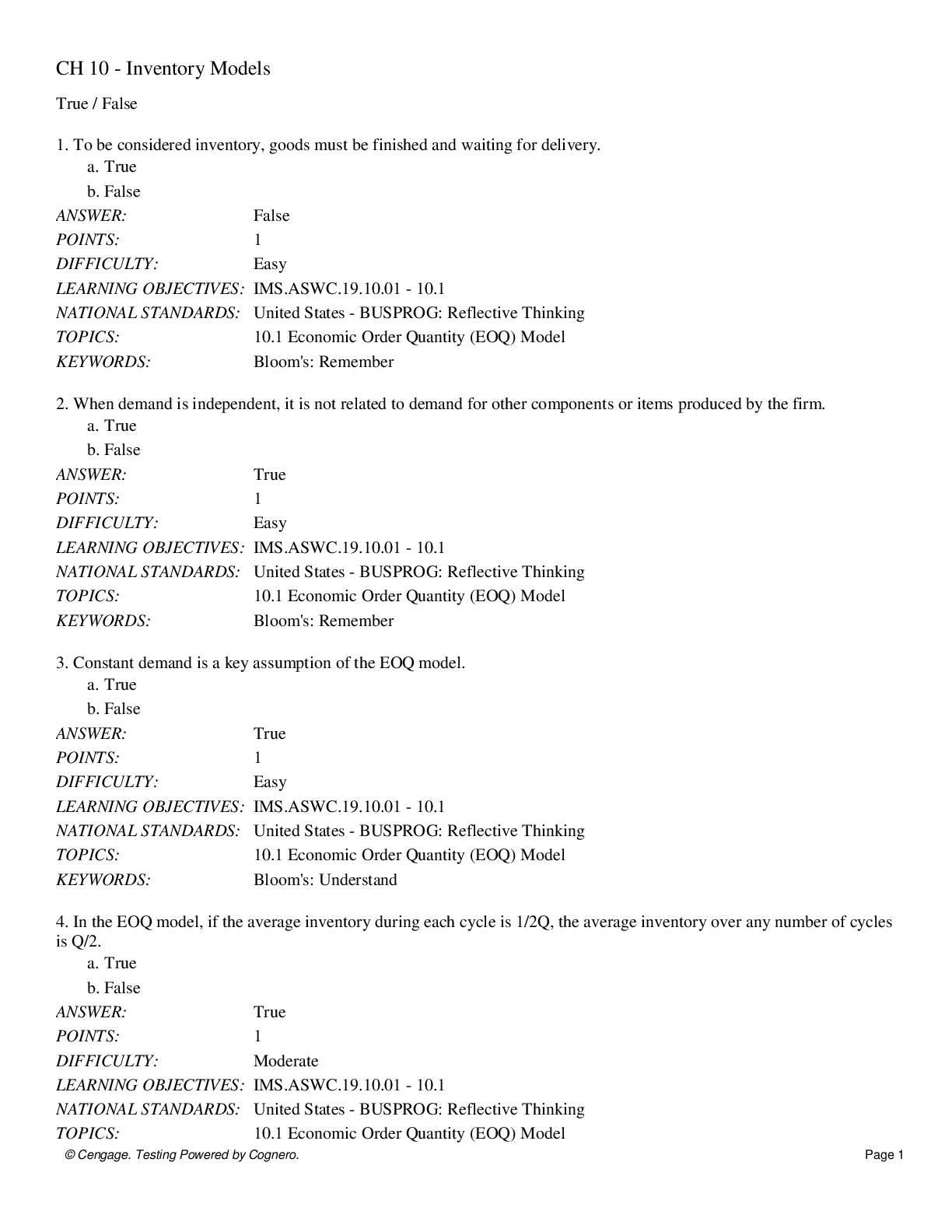
Buy this document to get the full access instantly
Instant Download Access after purchase
Add to cartInstant download
We Accept:

Reviews( 0 )
$6.00
Document information
Connected school, study & course
About the document
Uploaded On
Nov 07, 2019
Number of pages
20
Written in
Additional information
This document has been written for:
Uploaded
Nov 07, 2019
Downloads
0
Views
290
















